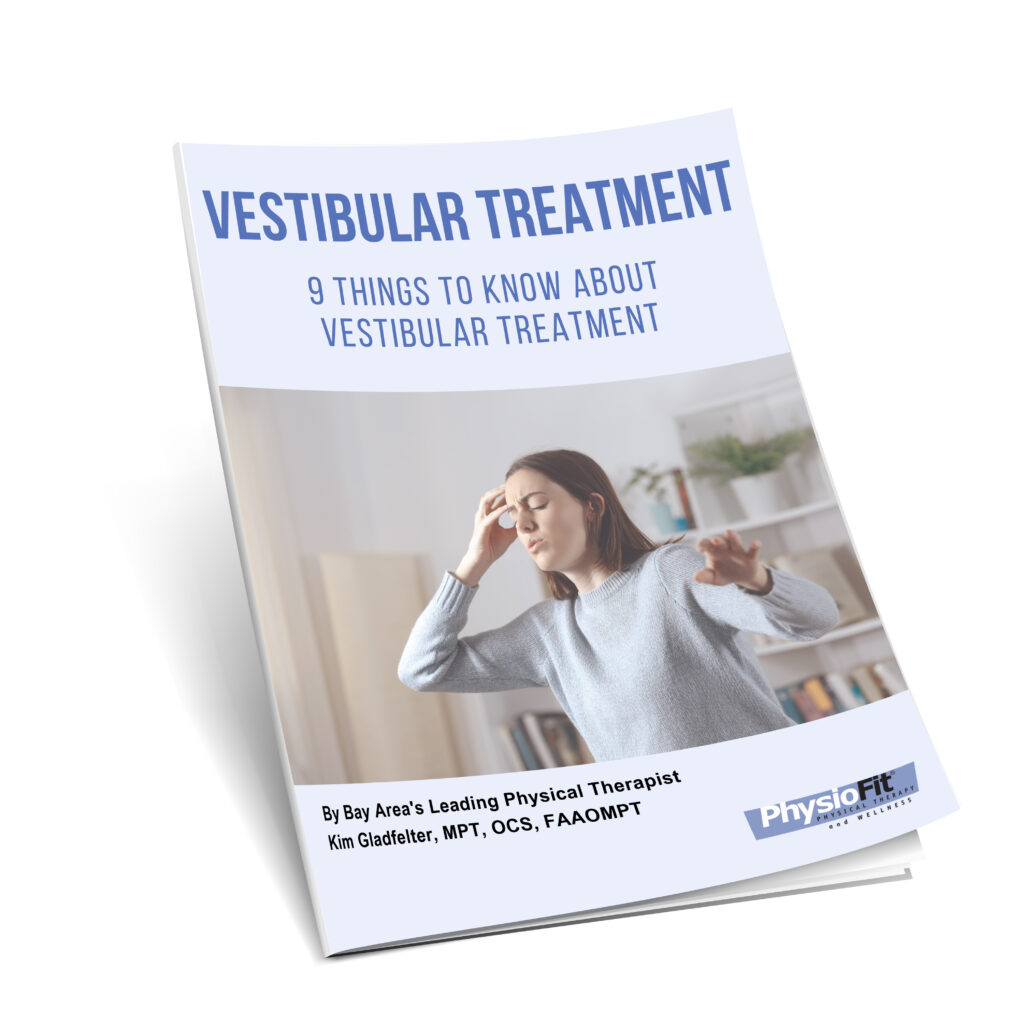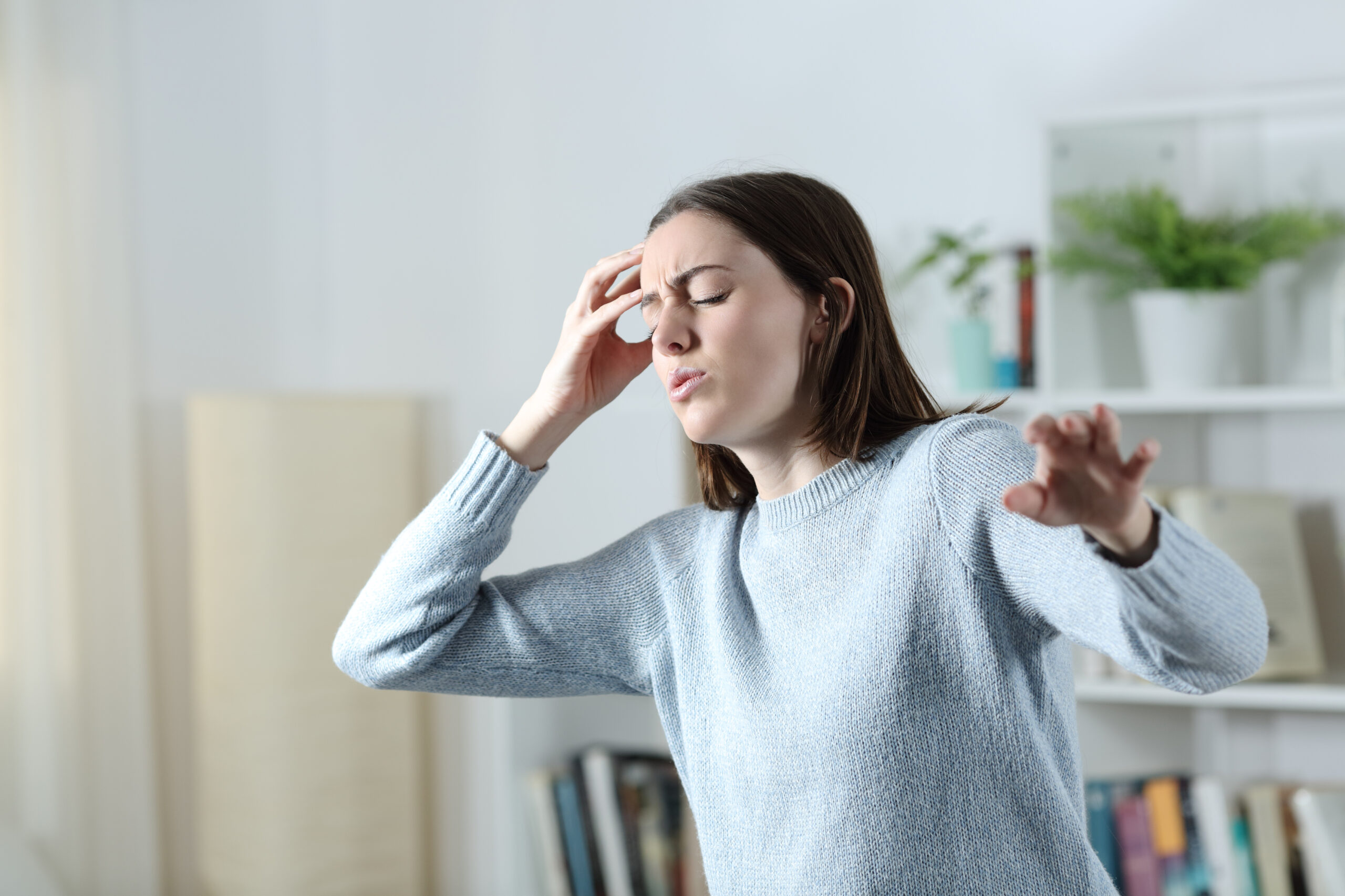Vestibular Rehabilitation
Nearly half of the adult population reports symptoms of dizziness, vertigo, or imbalance.
Understanding Vestibular Rehabilitation
Vestibular rehabilitation is a specialized form of therapy that aims to address disorders and conditions affecting the vestibular system, which is responsible for maintaining balance and spatial orientation. While specific treatment approaches may vary depending on the individual's condition and the healthcare provider's expertise, here are some common components of vestibular rehabilitation:
- General conditioning
- Functional training
- Ocular motor exercises
- Gaze stabilization
- Adaptation exercises
- Habituation exercises
- Benign Paroxysmal Positional Vertigo (BPPV) maneuvers
- Balance exercises

PhysioFit's unique therapy programs can help you reduce or eliminate these symptoms. In addition, we will teach you how to independently manage your condition for the long term. Our effective holistic approach consists of:
A thorough evaluation is conducted to assess the patient's symptoms, medical history, and physical capabilities. This may involve tests such as balance assessments, and subjective questionnaires to determine the extent of vestibular dysfunction.
Based on the assessment results, a customized exercise program is developed. This typically includes a series of eye, head, and body exercises designed to improve balance, coordination, and gaze stability. The exercises may involve head movements, tracking objects with the eyes, and maintaining balance under different conditions.
These exercises are aimed at desensitizing the patient to movements or situations that trigger symptoms, such as dizziness or vertigo. By gradually exposing the individual to these triggers in a controlled manner, the brain's response can be retrained, reducing symptoms over time.
The therapist may incorporate activities to improve the patient's walking and balance. This can involve exercises that challenge stability on different surfaces, uneven terrain, or while performing dual tasks to simulate real-life situations.
Patients are educated about their condition, triggers, and strategies to manage symptoms in their daily lives. Lifestyle modifications, such as changes in diet, hydration, sleep patterns, and stress management, may also be discussed to support recovery.
Throughout the treatment process, the patient's progress is regularly monitored and adjustments to the exercises and treatment plan are made accordingly. This ensures that the therapy remains effective and targeted to the individual's needs.
Signs & Symptoms
Dizziness
Blurred vision
Disorientation
Feeling Off-Balance
Feeling as if you are floating
Feeling as if the world is spinning (Vertigo)
Falling or Stumbling
Brain Fog
Hearing Loss
Nausea
Motion Sickness
Is there more the one kind of vestibular disorder?
An acoustic neuroma, also known as a vestibular schwannoma, is a significant yet noncancerous growth that emerges on the protective covering of the vestibulocochlear nerve within the inner ear. This nerve, commonly referred to as the acoustic nerve, plays a crucial role in transmitting both auditory and balance signals to the brain. With the progressive enlargement of an acoustic neuroma, it exerts pressure on the vestibulocochlear nerve, typically resulting in symptoms such as hearing impairment, tinnitus, and episodes of dizziness or unsteadiness.
When a virus invades the body, the immune system springs into action to protect it. However, there are instances when the immune system malfunctions and mistakenly identifies the body's own cells as foreign invaders like viruses or bacteria. This phenomenon is known as autoimmunity. Autoimmunity can lead to the immune system attacking various parts of the body, including the ear. When the immune system targets the ear specifically, it is referred to as autoimmune inner ear disease (AIED). The damage and functional deterioration caused by AIED can occur swiftly, with the progression being rapid.
BPPV is a common problem with the inner ear that can make you feel dizzy and off-balance. It happens when tiny calcium crystals, called otoconia or "ear rocks," gather in the inner ear. These crystals can get jostled around when you move your head, tricking your brain into thinking you're moving when you're not. This leads to feelings of vertigo and dizziness.
When both sides of the vestibular system are affected, it becomes challenging to maintain balance, particularly in low-light conditions or on uneven ground. Additionally, the person may experience blurred vision when moving their head. Bilateral vestibular hypofunction or loss can happen due to various underlying issues.
CANVAS is an acronym that helps remember a combination of three conditions: cerebellar ataxia, neuropathy, and vestibular areflexia. It is very rare to find patients with all three of these conditions together. CANVAS patients experience problems with coordination (cerebellar ataxia), damage to peripheral nerves (neuropathy), and loss of vestibular function (vestibular areflexia). Each of these conditions individually affects balance, but when they occur together, balance disturbances become more severe.
Neck pain and dizziness often occur together, but it can be challenging to determine if they are connected or simply coincidental. While true spinning vertigo is uncommon in this syndrome, a more precise term for it is "cervicogenic dizziness." However, diagnosing cervicogenic dizziness can be controversial as there are no specific tests to confirm it as the underlying cause of dizziness.
A cholesteatoma is an abnormal skin growth that develops in the middle ear behind the eardrum. It typically forms as a result of frequent infections and appears as a cyst or pouch that accumulates layers of old skin within the ear. As the cholesteatoma grows, it can damage the fragile bones of the middle ear. This can lead to hearing loss, dizziness, and even facial muscle paralysis.
Traumatic Brain Injury (TBI) can disrupt or damage the vestibular system, leading to vestibular dysfunction. This can result in symptoms such as dizziness, imbalance, and difficulty with coordination and spatial awareness. Treatment options, including vestibular rehabilitation therapy, aim to improve balance and alleviate these symptoms.
An enlarged vestibular aqueduct is usually accompanied by an enlargement of the endolymphatic duct and sac, which help maintain the volume and ionic composition of the endolymph necessary for transmitting hearing and nerve signals to the brain. When EVA causes hearing loss or balance symptoms, it is referred to as enlarged vestibular aqueduct syndrome (EVAS).
Labyrinthitis and vestibular neuritis are disorders resulting from an infection that inflames the inner ear or the vestibulo-cochlear nerve (the eighth cranial nerve), which connects the inner ear to the brain. Neuritis (inflammation of the nerve) affects the vestibular branch of the vestibulo-cochlear nerve, resulting in dizziness or vertigo but no change in hearing. Labyrinthitis (inflammation of the labyrinth) occurs when an infection affects both branches of the nerve, resulting in hearing changes as well as dizziness or vertigo.
Ménière’s disease is a vestibular disorder that produces a recurring set of symptoms as a result of abnormally large amounts of a fluid called endolymph collecting in the inner ear. The exact cause of Ménière’s disease is not known. The four classic symptoms are vertigo, tinnitus, a feeling of fullness or pressure in the ear, and fluctuating hearing.
Neurotoxic vestibulopathy is a poisoning of neurons in the brain that help control balance as a result of exposure to a neurotoxin (naturally occurring substance), such as lead, or a neurotoxicant (synthetic substance), such as the anti-malarial drug, mefloquine (a.k.a. Lariam).
Otosclerosis is the abnormal growth of bone in the inner ear. This bone prevents structures within the ear from working properly and causes different types of hearing loss, depending on which structure within the ear is affected. In addition to hearing loss, some people with otosclerosis experience dizziness and balance problems.
Ototoxicity ("ear poisoning") is due to exposure to drugs or chemicals that damage the inner ear or the vestibulocochlear nerve, which sends balance and hearing information from the inner ear to the brain. Ototoxicity can result in temporary or permanent disturbances of hearing, balance, or both. Many chemicals have ototoxic potential
Until recently, most medical professionals assumed that problems with vestibular function primarily affect adults, with only a small number of children being affected. However, there is growing evidence of vestibular system dysfunction in children, with consequent problems with gaze stability (seeing clearly with head movement), balance ability and/or the development of balance abilities, and dizziness.
A perilymph fistula is a tear or defect in one of the small, thin membranes that separate the middle ear from the fluid-filled inner ear. When a fistula is present, changes in middle ear pressure will directly affect the inner ear, stimulating the balance and/or hearing structures and causing symptoms.
Presbyvestibulopathy is a type of vestibular disorder that occurs with aging and may be a cause of such symptoms for many individuals. Studies demonstrate that age-related breakdown of cells in the vestibular system can cause dizziness, imbalance, and other symptoms of PVP. Vestibular rehabilitation (VR) with a physical therapist is the primary treatment approach.
Secondary endolymphatic hydrops involves abnormalities in the quantity, composition, and pressure of an inner-ear fluid called endolymph, apparently in response to an event or underlying condition such as head trauma or ear surgery. It can occur with other inner ear disorders, allergies, or systemic disorders.
Superior semicircular canal dehiscence syndrome results from an opening (dehiscence) in the bone overlying the superior (uppermost) semicircular canal within the inner ear. With this dehiscence, the fluid in the membranous superior canal (which is located within the tubular cavity of the bony canal) can be displaced by sound and pressure stimuli, creating certain vestibular and/or auditory signs and symptoms.
Migraine, a disorder usually associated with headache, is extremely common and can cause several vestibular syndromes. Studies suggest that about 25 percent of migraineurs experience dizziness or migraine during attacks. Migraine-associated vertigo (MAV) or vestibular migraine can occur with or without pain.
Vestibular paroxysmia is an episodic vestibular disorder that usually presents with a high frequency of attacks. It is assumed that vestibular paroxysmia occurs due to compression of the eighth cranial nerve (otherwise known as the vestibulocochlear nerve) by an artery. This nerve supplies the inner ear (which assists with balance) and the cochlea (the organ of hearing). Diagnosis of this condition is often based on the patient’s symptoms.
The vertebral and basilar arteries carry blood to the inner ear labyrinth, the vestibulocochlear nerve, and the brainstem. When blood flow through these vessels is restricted for any reason, it is called vertebrobasilar insufficiency. This is a common cause of vertigo in the elderly. Vertigo occurs suddenly without warning, usually lasts for several minutes, and can also be accompanied by nausea, vomiting, headache, and impaired vision.
Move better. Live better.
Move better.
Live better.
PhysioFit Physical Therapy & Wellness, like Los Altos itself, combines an inviting, community environment with exceptional talent. Founded and led by Kim Gladfelter, a keen, well-rounded expert of healing through movement and a dedicated team who takes a holistic approach to optimal health.
How Vestibular Rehabilitation Works:
Understand your symptoms
- Thorough talk with your therapist
- Go over weak areas
- See what causes your symptoms
- Test GAIT & balance
- Determine lifestyle contributors


Get the care you need
- Get personalized treatment
- Direct relationship with specialist
- Review goals and set milestones
- Focus on a holistic approach to your treatment
Get your desired outcome
- Be more independent, less worry
- Do any exercise/activity and stay active without feeling nausea and dizziness
- Change positions without the worry of loss of balance
- Move your body normally to increase mobility and lead an active lifestyle

Want Some Help?
Choose Which One Works Best For You...
Just click one of the buttons above and then fill out the simple form.
What Our Clients Say
H.S.
“I was totally skeptical coming in. Even a little resistant. But I had the best session ever. I keep waiting for “the catch”. Like, how could this have possibly worked within an hour– something that I’ve been carrying around, in and out of therapy, for years? But now, two months later, I still feel free of my burden. Before I left, I took a bunch of Divya’s business cards. I have a few friends who could really use her help!”
Los Altos, CA
D.A.
“I have been seeing Janet Perrino for multifaceted neuro-muscular-skeletal-joint issues combined with fibromyalgia. Janet’s knowledge of anatomy and how it affects the function of body parts is golden and unmatched by any other physical therapist or even doctors. She was able to quickly figure out my problems and find solutions that resulted in, pretty much, instant improvement and pain relief. Incredibly grateful for all the help and treatments.”
Los Altos, CA
What You Won't Get At PhysioFit
- You won’t be treated by a physical therapist treating 2-4 other people in the same room.
- You won’t waste time playing musical chairs on useless machines.
- You won’t be with a therapist for 5-10 minutes, where they show you the same basic exercises they give to everyone – regardless of what YOU might actually be going through.
- Your treatment will NEVER be influenced by what an insurance company will cover.
- We’ll never tell you, “this just happens as we get older, just take some pain medication.”
Free Guide For Anyone
Who Wants To End Vestibular Symptoms:
9 Things to Know About Vestibular Treatment


 Los Altos, CA
Los Altos, CA



